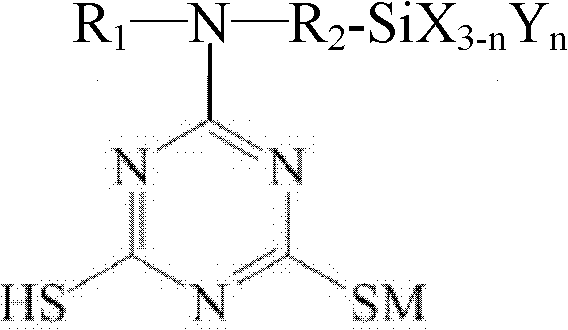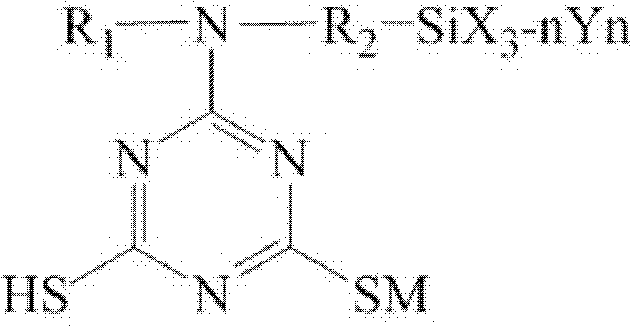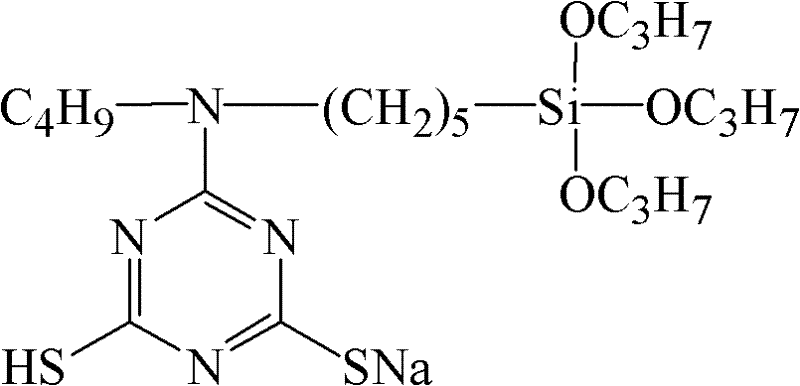A method for bonding the surface of aluminum or aluminum alloy to resin material
A technology of aluminum alloy surface and resin material, which is applied in the field of bonding aluminum or aluminum alloy surface and resin material, can solve problems such as devices with complex shapes, and achieve the effects of high bonding strength, high stability, and simple operation process
- Summary
- Abstract
- Description
- Claims
- Application Information
AI Technical Summary
Problems solved by technology
Method used
Image
Examples
Embodiment 1
[0064] The metal parts to be bonded are pure aluminum substrates with a size of 50×30×0.2 (mm), and the resin material to be bonded is low-density polyethylene (LDPE). Fast bonding is achieved through the following steps:
[0065] Step 1): Self-assemble into a polymer nanofilm on the surface of the pure aluminum substrate and the surface of LDPE:
[0066] The solvent of the self-assembly solution is dehydrated alcohol: water=95:5 (volume ratio), and the alkoxysilane compound with reactive mercapto groups is:
[0067]
[0068] The concentration is 1.0mmol / L; the aging time of the assembly solution is 24h;
[0069] The configuration process of the self-assembly solution is as follows: firstly weigh the reactive mercapto alkoxysilane compound according to the concentration of the solution to be configured and put it into the volumetric flask, then add absolute ethanol at a ratio of 95:5, and then add Ionized water;
[0070] The assembly is as follows: the material to be trea...
Embodiment 2
[0081] The metal part to be bonded is an aluminum-zinc alloy substrate with a size of 50×30×0.3 (mm), and the resin material to be bonded is polypropylene (PP). The fast bonding is achieved through the following steps:
[0082] Step 1): Preprocessing
[0083] First, the aluminum-zinc alloy substrate was cleaned with pure acetone solvent, and the polypropylene was ultrasonically washed with absolute ethanol for 20 minutes, and dried after washing;
[0084] Then, use 10% SK-144 alkali solution to degrease the surface of the aluminum-zinc alloy substrate at 60°C, rinse the surface with clean water and dry it;
[0085] Then, the surface of the aluminum-zinc alloy substrate and the surface of polypropylene were subjected to corona discharge treatment for 20 s with a low-temperature plasma power supply.
[0086] Step 2): Self-assemble into a polymer nanofilm on the surface of the aluminum-zinc alloy substrate and the surface of polypropylene:
[0087] The solvent of the self-assem...
Embodiment 3
[0100] The metal parts to be bonded are aluminum-magnesium alloy substrates with a size of 50×30×0.3 (mm), and the resin material to be bonded is high-density polyethylene (HDPE). The fast bonding is achieved through the following steps:
[0101] Step 1): Preprocessing
[0102] Firstly, the Al-Mg alloy substrate was cleaned with pure acetone solvent, and the HDPE was ultrasonically washed with absolute ethanol for 15 minutes, and dried after washing;
[0103] Then, degreasing the surface of the aluminum-magnesium alloy substrate with an aqueous solution of 10% SK-144 alkali solution at 70° C., rinsing the surface with clean water and drying it;
[0104] The surface of the aluminum-magnesium alloy substrate and the surface of the HDPE were then subjected to corona discharge treatment for 20 s with a low-temperature plasma power supply.
[0105] Step 2): Self-assemble into a polymer nanofilm on the surface of the aluminum-magnesium alloy substrate and the surface of HDPE:
[010...
PUM
 Login to View More
Login to View More Abstract
Description
Claims
Application Information
 Login to View More
Login to View More - R&D
- Intellectual Property
- Life Sciences
- Materials
- Tech Scout
- Unparalleled Data Quality
- Higher Quality Content
- 60% Fewer Hallucinations
Browse by: Latest US Patents, China's latest patents, Technical Efficacy Thesaurus, Application Domain, Technology Topic, Popular Technical Reports.
© 2025 PatSnap. All rights reserved.Legal|Privacy policy|Modern Slavery Act Transparency Statement|Sitemap|About US| Contact US: help@patsnap.com



